Top 15 Creepy Deep Sea Creatures
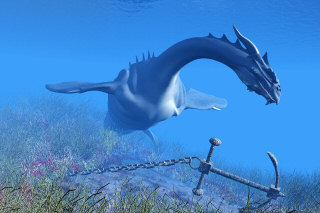 With GPS on cars and satellite maps on smartphones, the world feels a lot
smaller and more familiar than the days of hand-drawn cartography. Taking a
wrong turn can be corrected by pushing a button. With the exception of some
private islands, it’s virtually impossible to have an address no one can look
up. This expansion of knowledge and access comes with a price, though, and that
is a loss of mystery about the planet. The majority of the world can be viewed
from the comfort of your home, at street level. Unexplored continents are no
longer written off as filled with dangerous, mythical beasts—the stuff of our
wildest dreams and most entertaining folktales. Some propose the only frontier
left for intrepid explorers is among the stars, but if you are looking to
intrigue your imagination and fuel your fancy, sometimes it’s better to stop
looking up and start looking down—deep down. The depths of Earth’s oceans are
like the subterranean underworld myths of old come to life. With GPS on cars and satellite maps on smartphones, the world feels a lot
smaller and more familiar than the days of hand-drawn cartography. Taking a
wrong turn can be corrected by pushing a button. With the exception of some
private islands, it’s virtually impossible to have an address no one can look
up. This expansion of knowledge and access comes with a price, though, and that
is a loss of mystery about the planet. The majority of the world can be viewed
from the comfort of your home, at street level. Unexplored continents are no
longer written off as filled with dangerous, mythical beasts—the stuff of our
wildest dreams and most entertaining folktales. Some propose the only frontier
left for intrepid explorers is among the stars, but if you are looking to
intrigue your imagination and fuel your fancy, sometimes it’s better to stop
looking up and start looking down—deep down. The depths of Earth’s oceans are
like the subterranean underworld myths of old come to life.
Here, there really are dragons—and vampires, and zombies. Habitats for these
animals are harsh: high pressure, low light, extreme temperatures, and scarce
resources. But these conditions have proved a successful evolutionary breeding
ground for animals so bizarre no mad scientist could design them in a lab. Cross
the saltwater Styx and meet 15 creepy inhabitants of the aquatic abyss.
15) Snipe Eel
The most innocuous description you could give this fish is that it looks like
a long ribbon threaded on a large needle—because of this, it is also called a
ribbon eel. Many feel this eel looks like a toothy tapeworm. Snipe eels are very
long—some just over a meter and a half—and have long bone snouts that resemble
the beak of a snipe. Snipe eel bodies are extremely slender, meaning that even
the longest of them weigh only a few ounces. This makes them delicate creatures
that are difficult to study due to fragmentation of their narrow frame as they
are hauled up to the surface or caught in deep sea fishing nets.
Snipe Eel - Nemichthys scolopaceus
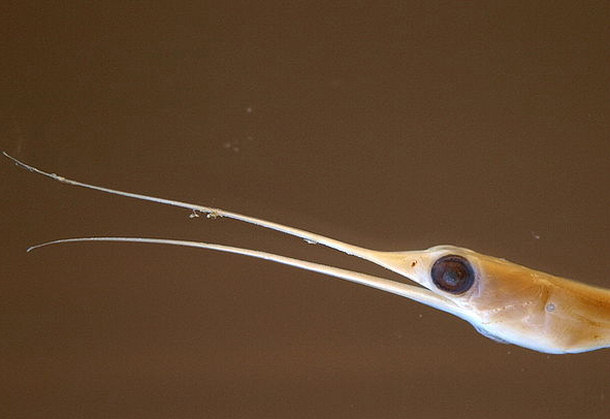
By opencage さん (//ww.opencage.info/pics/large_17632.asp) [CC-BY-SA-2.5],
via Wikimedia Commons
The eyes of snipe eels are large for their body and orb-like to trap the most
meager rays of light making it down to their habitat in deep water. Some snipe
eels have armored heads, others have saw-like teeth, though the majority have
small, hooked dentition. All of them will cause a unsettling sense of dissonance
with your idea of proportions as their skinny, slithering body is up to 75 times
the length of its width.
14) Frilled Shark
The term “frilled” may conjure images of decoration and decadence, but this
creepy creature hardly has a place in a doily adorned parlor. Reaching about 2
meters in length, the frilled shark is a rare “living fossil” known for its
primitive characteristics and ruffled (frilled) gills. Its long, serpentine body
and uncanny spear-shaped head suggest it as one of the sources for sea serpent
myths.
Frilled Shark Head - Chlamydoselachus anguineus
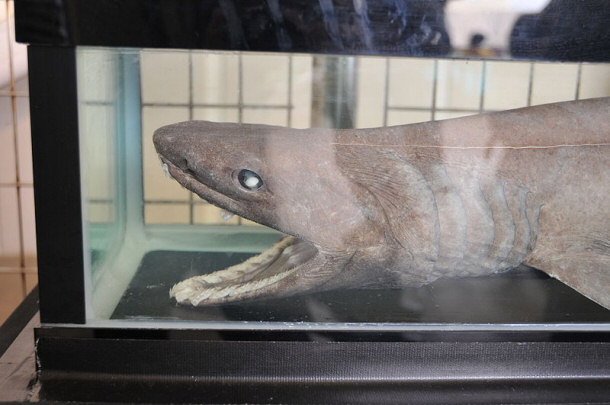
By saname777 from Tokyo, Japan (Shin-Enoshima Aquarium (2008.8.23) - 181) [CC-BY-2.0],
via Wikimedia Commons
Frilled sharks feed mostly on squid and other soft bodied animals living up
to 1500 meters below the ocean’s surface. There are roughly 300 teeth in the
mouth of a frilled shark, all widely spaced and multi-point like a bristling
mouth with a thousand needle points. Its distensible jaws have very little
biting power, however, so any prey it grabs must be swallowed whole and quickly.
Because of these qualities as well as its body shape, scientists think the shark
attacks its prey like a snake, loosely circling and then striking after all
chance of escape is cut off.
13) Proboscis Worm
Proboscious worms, also known as ribbon worms, cover an entire phylum of
animals known as Nermertea after the Greek sea-nymph Nermertes. Some very small
ones do live in shallow seawater or fresh water, but there are a few species
found exclusively in the deep. These gelatinous, primitive creatures can grow to
enormous lengths—one found was 54 meters long. The proboscis worm takes its name
from a retractable proboscis used in feeding that everts from under its mouth by
specialized muscles. One class of these worms—Enopla—contains a dagger on the
end of this member. The worms both scavenge and attack live prey. In fact, there
is little the creatures refuse to eat.
Proboscis Worm - Nemertea
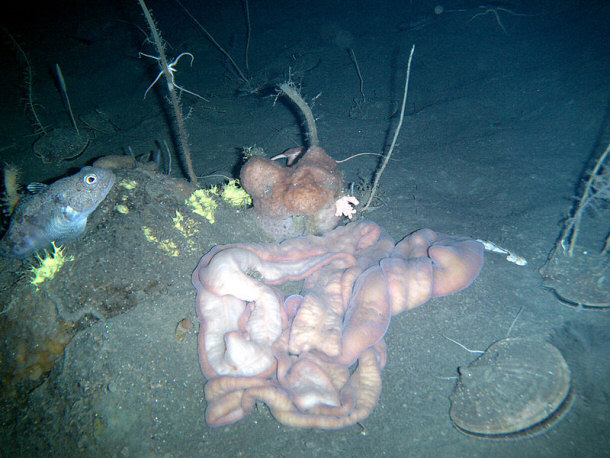
It has few if any known predators, and often lies coiled on the ocean floor
in a pattern that resembles a pile of intestines. For shelter, many varieties
choose to hide in crevices between rocks, or make mucus covered burrows. A few
species move on cilia over a slime trail they excrete, but the larger species in
the deep often move with an undulating muscular wave pattern resembling a slow
snake. Algae and other sessile animals sometimes anchor themselves to some of
these creatures, while others contain an irritant in their skin.
12) Coffinfish
Disappointingly, coffinfish bear little resemblance to coffins. These
prickly, brightly-colored bulbous bodies with long tails strongly suggest
gourds, but one look in its mouth will assure you this small fish’s name is apt.
Like many deep sea dwellers, coffinfish have a disproportionately large, gaping
mouth—and in this case, it appears black and hollow like a deep grave. The
feature is so prominent it inspired the scientific name for coffinfish:
melanostomus, which comes from the Greek “melanos” for “black” and “stomus” for
“mouth.” Even closed, this maw produces a solemn frown on coffinfish. Though we
doubt this is a sign of mourning for the fish that pass that way to eternal
slumber.
Coffinfish - Chaunax endeavouri
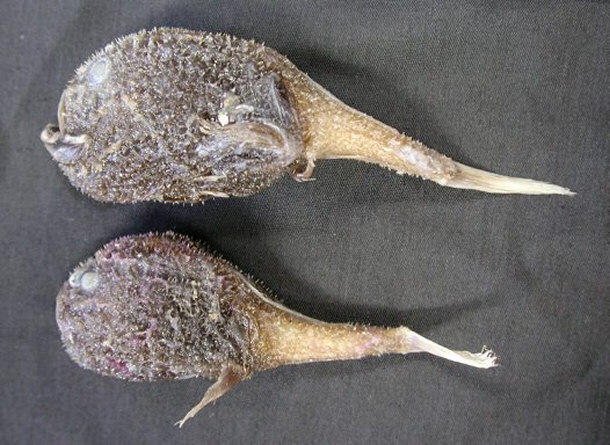
Have no fear about slipping into this void, however. Most coffinfish grow to
about 10 centimeters, and tend to stick to quietly trawling the mid-depth
continental slopes of the ocean for easy prey.
11) Gulper Eel
Gulper eels are also called pelican eels. They lack a lot of bones common to
fish, including ribs, the symplectic bone of the skull, and a bony flap normally
protecting the gills. These eels also lack a swim bladder, scales, and pelvic
fins, giving them the appearance of a very simple, primitive creature. These
traits combined make the eel a poor swimmer, meaning it must rely on a single
bioluminescent organ on the tip of its tail to act as a lure for its prey.
Gulper Eel - Eurpharynx pelecanoides
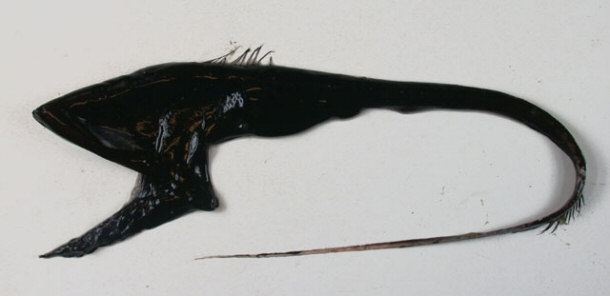
By Alexei Orlov ([1]) [CC-BY-3.0],
via Wikimedia Commons
While examination of stomach contents and teeth indicate this species eats
small crustaceans, gulper eels have enormous mouths that are extremely
disproportionate in length and width to their long, slender bodies—up to one
fourth of their one meter length. The hinge of this eel’s jaw is set back and
very loosely hinged, giving these creatures the capability of swallowing
something much larger than themselves. Additionally, the shape of the mouth
appears to form a distensible pouch like a pelican’s, giving the eel its other
common name and creating a mystery for marine biologists. The theory is these
creatures use their pouches as a net to capture larger amounts of the tiny prey
it eats, but the habits of gulper eels are difficult to study as they range up
to 3000 meters below sea level.
10) Black Dragonfish
There are several species of fish that we commonly call “dragonfish,” but
these are in a class all their own—or, well a genus and species: Idiacanthus
atlanticus. Heavily sexually dimorphic, males are nondescript, unadorned little
brown fish only a few centimeters long and not even having a full GI system.
Females—on the other hand--grow up to 40 centimeters long, and are pitch black
with dark round eyes, a chin barbel, and large razor teeth.
Black Dragonfish - Idiacanthus atlanticus
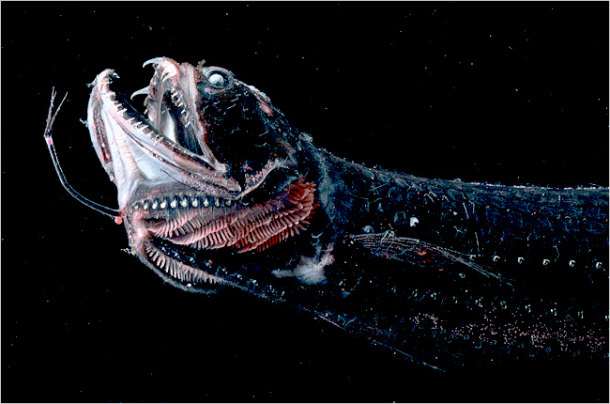
Black dragonfish use bioluminescence both to attract prey and ward off
predators. The barbel lights up and bobs like a lure—a common trait in deep sea
fish—and most of the body will light up when threatened, from the lateral line
to the tips of the fins. What makes these abilities unusual in this species is
in addition to typical blue spectrum light, dragonfish also produce a red light
with such a long wavelength it is nearly infrared. While this is mostly out of
range for human vision, it is detectable and highly attractive to some other
species in the black dragonfish’s natural habitat.
9) Sea Devil
Another sexually dimorphic species, sea devils comprise several species of
angler fish. It has a bioluminescent barbel on its forehead that it can wiggle
around to resemble the movements of small prey to lure in its own meal. Its jaws
are large and inclined with inward facing teeth that, while long, can be
depressed to allow larger prey to enter its mouth without impediment. Once
inside, any attempt to swim backwards will cause these teeth to catch and
prevent escape.
Sea Devil
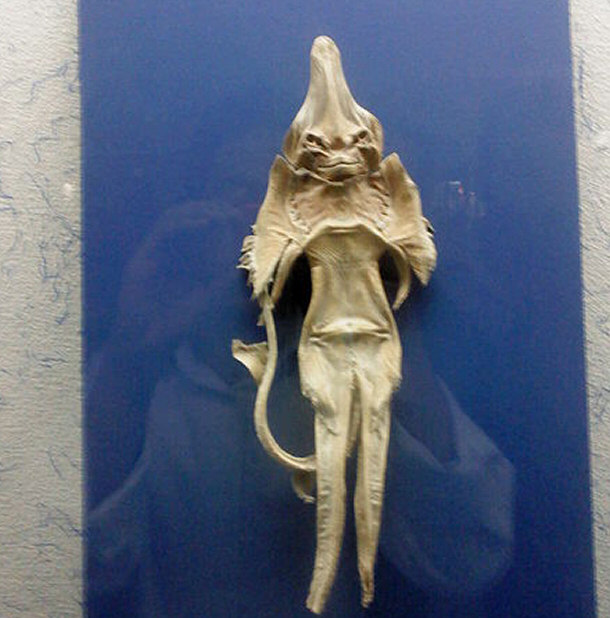
By Lovej (Own work) [CC-BY-SA-3.0],
via Wikimedia Commons
What is really strange about sea devils is that males and females live
together in a joined, symbiotic state. Males are much smaller than females—14
centimeters as compared to 1.2 meters—and they live the majority of their lives
attached to a female’s body. Slowly, the male’s systems began to merge with the
female’s to sustain his life, and eventually, the two even share a circulatory
system. Not needed, the male’s body atrophies except for an expanding set of
testicles that allow the pair to reproduce. Rather than a parasitic
relationship, science considers this to be an example of a chimera. While other
medical chimeras exist—even in humans—this is one of the only naturally
occurring examples involving two organisms originally born separately.
8) Viperfish
Yet another deep sea dweller in on the barbel lure accessory trend is the
viperfish—in this case, the barbel originates from the front of the dorsal fin
instead of the head. These fish also possess a few bioluminescent photophores on
their sides they can flicker on and off, allowing them to blend in with light
filtering down from the surface. This trick camouflages them from predators
which lurk in the water below. Unlike many species that use this system of lures
and camouflage, viperfish don’t passively wait around or slowly float,
anticipating a meal to find them. Instead, these fish are vicious hunters.
Head of a Pacific Viperfish - Chauliodus
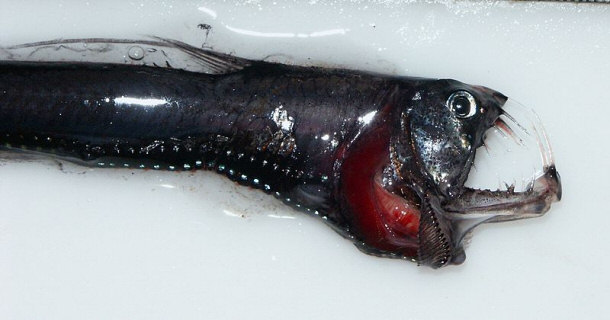
The viperfish’s fang-like teeth are not retractable like the type of snake
whose name it bears. Rather, its elongated, pronounced dentition—often over half
the size of the fish’s head--prevents the massive jaws from ever fully closing.
When this fish senses prey within range, they take off at high speed and use
these nightmarish teeth to impale their prey. This adaptation to life as a living
spear is so complete that the first vertebrae in a black dragonfish’s neck is
specifically designed to be a shock absorber, in the event of high-speed collisions. With
female viperfish topping out at 40 centimeters, this is one creature you don’t
want to play chicken with.
7) Vampire Squid
Speaking of impalers, here is a creature that takes after Vlad the Impaler
fashion-wise—at least, the modern cinema version better known as Dracula.
Unfortunately for monster movie aficionados, this squid doesn’t suck blood. It
does have webbing between its tentacle arms, however, that spread as it swims
like a velvety, deep-red to black colored cloak. This important adaptation not
only makes the squid phylogenetically separate from the rest of its family, but
it provides surface area for retractable sensory filaments that allow the squid
to search for prey.
Illustration of a Vampire Squid - Vampyroteuthis infernalis
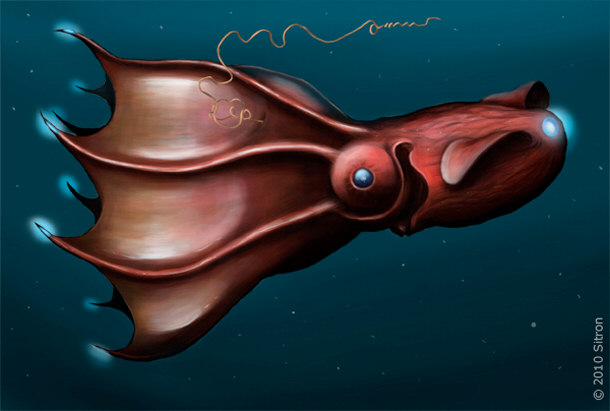
By This illustration was made by CitronYou must credit this : Citron (Own work) [GFDL or CC-BY-SA-3.0],
via Wikimedia Commons
The vampire squid becomes more spooky and worthy of its name when you
consider how its gelatinous body is covered in photophores, which is can flick
on and off in a mesmerizing bioluminescent pattern. In this way, the squid can
hypnotize surrounding creatures to make a mysterious escape or enthrall
unsuspecting prey that eventually fall victim to its bone-like beak. This squid
would certainly make Bela Lugosi proud.
6) Deep Sea Jellyfish
There are several varieties of jellyfish deep in the ocean, ranging from a
miniscule 1 centimeter in diameter up to a full meter across their bodies. Most
of them belong to the group called “coronate” jellyfish, which can often
resemble rings or ballerinas’ tutus, due to both their unique body shape and
flexibility. Their tentacles are sometimes much firmer than jellies we encounter
on the beach, and can stretch back up and over their bells, giving them the
appearance of being a crown of spines. In some species, these spines can also
extend downward, and are hard enough to be used as legs. One such species was
documented in 1875, but lost again until March of 2013. The specimen filmed off
the coast of Chile still captures the imagination with its interesting mix of
traits.
Deep Sea Scyphozoan Jellyfish - Atolla wyvillei
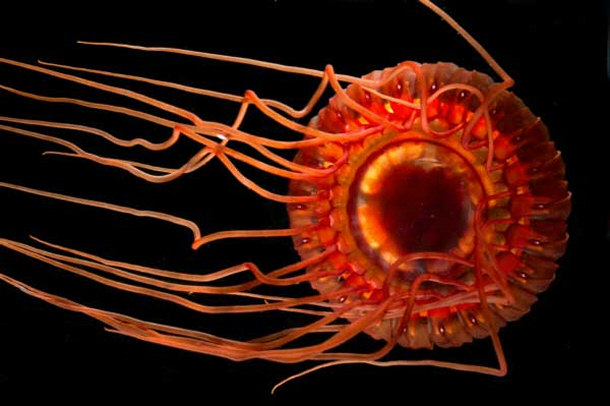
By NOAA Ocean Explorer from USA [CC-BY-SA-2.0],
via Wikimedia Commons
Some coronate jellies have a surface that can be nearly iridescent, but all
possess at least a core that is deep red in color. This helps them camouflage
the bioluminescence of consumed prey digesting in their bells. Some can also
defend themselves by squirting bioluminescent or phosphorescent material into
the water around them—like a squid’s ink—to confuse predators with shimmering
light. Others like atolla jellyfish have rings of photophores that, when
activated, allow them to create a confusing pinwheel affect by spinning around.
5) Sea Cucumber (Holothurians)
Not all sea cucumbers closely resemble the namesake fruit. Sea cucumbers
display a wide range of colors and textural features—bumps, spines, and
tentacles, as well as shapes—spherical to worm-like. Also called sea slugs,
these creatures are an important part of aquaculture for many markets, highly
prized for their muscles and their skin. Overharvesting is a severe problem in
Alaska, Australia, and the Yucatan, with most black market sea cucumbers being
exported to China. The Chinese and Japanese now farm them, but wild sea
cucumbers are often larger and more nutritious than farmed varieties. Sea
cucumbers have a unique capability of producing a purring sound that inspired a
piano movement by Erik Satie. Additionally, sea slugs have appeared in Japanese
haiku as well as an Edgar Allan Poe novel. While sounding more inspiring than creepy,
there are a couple secrets you may not know about them that will change your
mind.
Sea cucumbers already have a fairly flexible body. However, like us, they
also need connective tissues to provide structure, support, and some types of
voluntary motion. Collagen is a tough, fibrous protein found in ligaments,
tendons, some muscles, and even skin. It provides firmness and stability to
surrounding tissue, and in holothurians, provides body shape. Unlike most other
animals that rely on it for structural support, the sea cucumber can unhook its
collagen strands from one another, a feat analogous to us dismantling our
skeleton. As you can imagine, this allows the sea cucumber to liquefy its body,
letting it pass through impossibly small spaces.
Sea Cucumber on the Ocean Floor - Holothuroidea
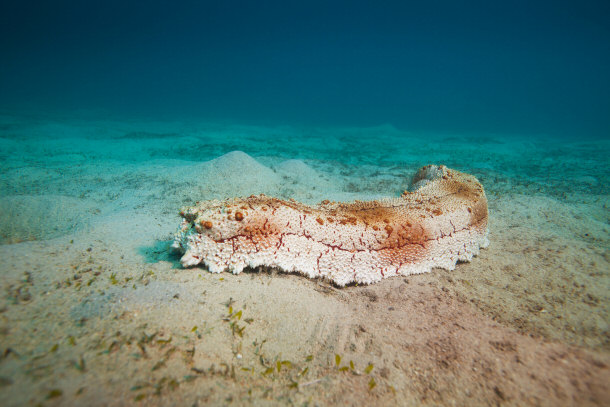
If for some reason the holothurian cannot escape into a nook or cranny, a sea
cucumber’s cloaca can expel sticky tubules that entangle predators—no word on
whether it also grosses them out or not. Should that fail, some varieties also
produce a saponin—soap like—toxin called holothurian that can fatally injure
most animals in the immediate area. Talk about offensive defenses.
4) Giant Isopod
The closest living relative of the giant isopod is the humble pill bug. This
underwater version is significantly more creepy than the roly-polies you played
with as a child, though, considering it can grow to a length of 40 centimeters
and weigh as much as 1.7 kilograms. A giant isopod’s eye contains 4000 facets
for catching even the weakest bit of light that makes it to the ocean floor. The
creature has managed to become a sensation in Japan, where live sized plush
replicas of the creature are sold, but the cuteness is lost once you turn from
the toys to the real thing. The mouths of giant isopods are powerful mandibles
designed to pierce, rip, and disembowel prey, making them skilled feeders for
nearly anything they find in their environment. In addition to live prey, they
also scavenge dead carcasses including whales, being extremely opportunistic and
adaptable.
Giant Isopod - Bathynomus giganteus
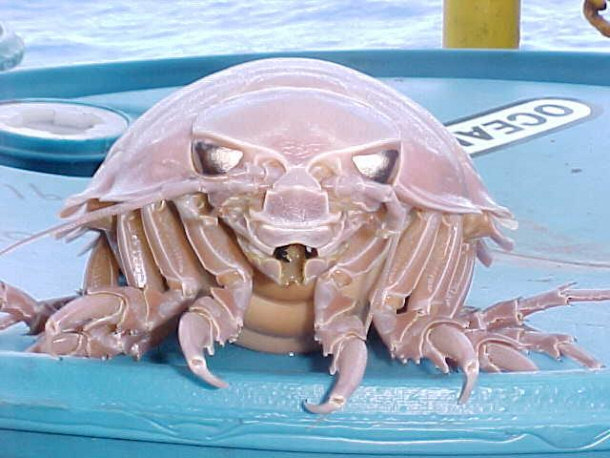
By friend of User:Borgx (//en.wikipedia.org/wiki/Image:ROACH.JPG) [GFDL or CC-BY-SA-3.0],
via Wikimedia Commons
If needed, though, they can easily go without food for eight weeks. One giant
isopod at Toba Aquarium in Japan reported housing a giant isopod who had not
eaten in four years. These isopods are adept at maintaining a low
energy-consuming state of semi-hibernation to account for their varied and
erratically occurring sources of food in the wild, and so in aquarium spaces,
can easily turn down a meal, leaving keepers scrambling to find fare that
placates these oversized, stubborn bugs.
3) Armored Sea Robin
Found off the western banks of the Atlantic, sea robins all have boxy bodies,
with large pectoral wings whose movements resemble birds’ wings. That may sound
graceful, but keep in mind sea robins also have spindly leg-like spines at the
front of these fins that stir up food as they swim close to the ocean floor,
giving them the appearance of “walking” like a creepy-crawly insectoid.
Additionally, more spines higher up on their bodies produce a mild toxin used to
ward off predators.
Armored Searobin - Peristedion miniatum

Armored sea robins in particular have a devilish appearance, averaging 30
centimers long with a translucent crimson red that shows off all their bony
ridges and plates. They also have bulging eyes that quickly turn opaque and pale
when pulled from the water, and a much more elaborate set of chin barbels than
other sea robins.
Sea robins possess a special muscle they can drum against their swim bladders
to produce a croaking sound similar to a frog’s. This has earned them the
nickname of “gurnard,” a play on the sound they make. They are an important food
source as a substitute for the rarer scorpionfish in bouillabaisse.
|
Zombie Worm - Osedax:
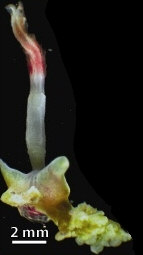
|
2) Zombie Worms
These are true members of the afterlife aquatic. The scientific name for this
genus of creatures is Osedax, which means bone-eating, and that is exactly what
these deep-sea denizens do. Zombie worms attach themselves to whale carcasses
that fall to the ocean floor. Though they lack a mouth, stomach, and anus, these
worms release an acid that dissolves osseous tissue. In symbiosis with a
bacteria involved in decay, the worms have feathery, plume-like gills for oxygen
exchange and dendritic structures for absorbing broken down proteins and lipids.
While the sexes are separate, males never grow past the larval stage, and,
inside, live within females like the endosymbiotic bacteria that help the worms
eat. The depths at which most species of zombie worms live, and the rarity of
whale falls, makes this a difficult animal to study. In the past few years,
however, we have made discoveries of relatives that live in more shallow
waters—one in particular is found just off the coast of Sweden, known there
casually as the “bone eating snot flower.”
1) Squidworm
This is a relatively new creature, documented for the first time off the
coast of the Philippines in 2007 and put in the news three years later.
Displaying traits of both animals it bears the name of, the squidworm is an
annelid—the same classification as earth worms and leeches—with a typical
segmented body. Its head covered in tentacles that initially made the creature
appear to be ingesting a small squid. Oddly, most of these arm-like appendages
are hard and used for breathing, with two more coiling, softer ones used for
feeding. Shorter, feathery bristles cover its nose area and provide sensory
information. Iridescent paddles grow along its 9 centimeter body, and the worm
uses these to propel itself in a vertical undulating motion.
Squidworm - Teuthidodrilus samae
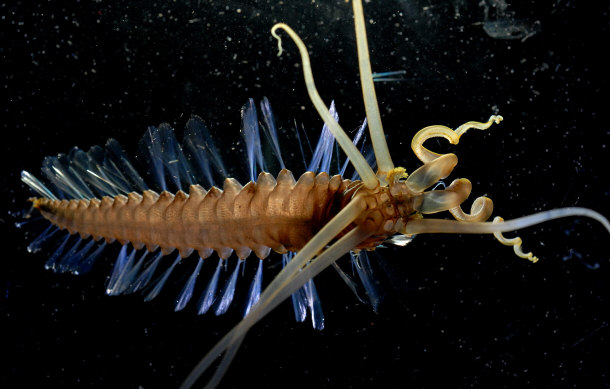
The creature occupies a strange mid-depth for worms, not quite to the ocean
floor, but definitely not in the shallows. Many scientists speculate its
ostentatiously arranged body represents a transitional form on its evolutionary
path as it adapts to this new, limited habitat. Cool as well as creepy.
Conclusion
The animals on this list cover the full spectrum of the definition of “creepy.” That is
nothing compared to the extreme examples of biodiversity that waits for you undiscovered on
the ocean’s floor and deep within its trenches. It is as distant and foreign a
world as any far off planet, with dangers and robust challenges that would tax
the resourcefulness of any pioneer. The creatures here fall to more than just
physical extreme in their present moment, but over the path of their entire
evolutionary history. Some have remained unchanged for eons, denizens of a
primordial kingdom that gives us insight into what a newly birthed, submerged
planet might look like. Others are still very conspicuously in the process of
evolving, a product of movement into unheard of habitats in the constant search
to survive changing conditions in the shallow waters and mid-depths humankind
has placed their mark on.
Just like the first marine explorers seeking out new land, those of us
probing the depths for new discoveries are still often hindered by the
limitations of technology. The specimens we do find, though, are ambassadors
that urge us on, reminding us not to give up in the push to learn more about the
70% of this planet that is blue and not green. This mission is doubly important
with the evidences we have of human effect on marine ecosystems. Even these
shockingly harsh climates are very delicately balanced systems, easily thrown
off by waste and rising carbon levels slowly eroding populations of creatures
from the bottom of the food chain up. As you have seen, many of these creepy yet
profoundly fascinating animals survive on plankton, shrimp, and small
crustaceans. Conditions that wreck the microcosms of these microscopic creatures
spell nothing but trouble for larger ones. Exploration is essential for
gathering knowledge about this little known, strange life in order to conserve
it. Because in the end, the fact we can have this much effect on animals so far
away from our own habitats is the most creepy part of the deep sea after all.
Nature
Top Lists:
15 Fascinating Facts about the Amazon Rainforest
15 Remarkable Facts About Bacteria
15 Remarkable Facts About Jellyfish
15 Little Known Facts About Elephants
15 Fascinating Facts about Earthquakes
15 Odd And Interesting Facts about Monkeys
Top 15 Myths about Snakes
Top 15 Myths about Horses
Top 15 Creepy Deep Sea Creatures
15 Unexpected Animals That Can Kill You Quickly
Top 15 Spider Myths
15 Beautiful Animals that are Now Extinct
Top 15 Most Amazing Snakes Around the World
15 Fascinating Facts about Snow
Top 15 of the World's Rarest Flowers
10 Most Emotional Animals
15 of the Most Venomous Creatures to Roam the Earth
15 Unusual Animal Defense Mechanisms
15 Unusual and Less Known Uses of Rocks
15 Unique Forest Creatures Less Known To Man
15 Interesting Facts About Time
15 Unknown Parasites You Never Knew Existed
15 Weird Trees Around The World
15 Wild Animals Deadly to Humans
15 Exotic Insects That Are Harmful & Deadly
15 Ridiculous Uses for Gold
Informational:
Preparing for a Disaster
Proof That We Are What We Are!
What is the Meaning of Life?
The Trend and Challenges Facing the Urban World
Creation Narratives and the Evolution Creationist Debate |